

New Kind of Cellular Suicide. Researchers identify a gene that drives a type of cellular suicide that differs from the more commonly observed apoptosis phenomenon.
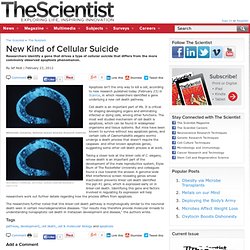
Wikimedia Commons, National Human Genome Research Institute Apoptosis isn’t the only way to kill a cell, according to new research published today (February 23) in Science, in which researchers identified a gene underlying a new cell death pathway. Cell death is an important part of life. It is critical for shaping developing organs and eliminating infected or dying cells, among other functions. The most well studied mechanism of cell death is apoptosis, which can be found in widespread organisms and tissue systems. Taking a closer look at the linker cells of C. elegans, whose death is an important part of the development of the male reproductive system, Elyse Blum of The Rockefeller University and colleagues found a clue towards the answer.
Celebration of a breakthrough tool for understanding RNA. A paper detailing an exciting technical advance, an RNA sequence-fluorophore complex called “Spinach”, garners 14 evaluations, making it one of the all-time highest rated papers on F1000.
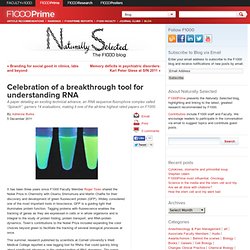
It has been three years since F1000 Faculty Member Roger Tsien shared the Nobel Prize in Chemistry with Osamu Shimomura and Martin Chalfie for their discovery and development of green fluorescent protein (GFP). Widely considered one of the most important tools in bioscience, GFP is a guiding light that illuminates protein function. Tagging proteins with fluorescence enables the tracking of genes as they are expressed in cells or in whole organisms and is integral to the study of protein folding, protein transport, and RNA-protein dynamics. Tsien’s contributions to the Nobel Prize included expanding the color choices beyond green to facilitate the tracking of several biological processes at once. Tags: GFP, RNA aptamer, RNA-fluorophore complex, spinach. Tracy Dale at SfN 2011. Why do some neurodevelopmental and neuropsychiatric diseases such as autism affect more boys than girls?
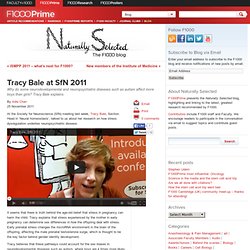
Tracy Bale explains. At the Society for Neuroscience (SfN) meeting last week, Tracy Bale, Section Head in ‘Neural homeostasis’, talked to us about her research on how stress dysregulation underlies neuropsychiatric disease. It seems that there is truth behind the age-old belief that stress in pregnancy can harm the child. Tracy explains that stress experienced by the mother in early pregnancy can determine sex differences in how the offspring deal with stress.
Early prenatal stress changes the microRNA environment in the brain of the offspring, affecting the male prenatal testosterone surge, which is thought to be the key factor behind gender identity development. Tracy believes that these pathways could account for the sex biases in neurodevelopmental diseases such as autism, where boys are 4 times more likely than girls to be affected. So long, and thanks… Back when the world was young and Naturally Selected was not yet a month old, I analysed how long it took Faculty of 1000 members to evaluate papers after they’d been published.
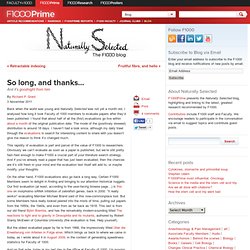
I found that about half of all the (first) evaluations go live within about a month of the original publication date. The mode of the (positively skewed) distribution is around 18 days. I haven’t had a look since, although my daily trawl through the evaluations in search for interesting content to share with you doesn’t give me reason to think it’s changed much. This rapidity of evaluation is part and parcel of the value of F1000 to researchers. Obviously we can’t evaluate as soon as a paper is published, but we’re still pretty fast–fast enough to make F1000 a crucial part of your literature search strategy. On the other hand, F1000 evaluations also go back a long way. But the oldest evaluated paper by far is from 1866, the impressively titled Über die Erweiterung von Arterien in Folge einer. Tags: valediction. Manel Esteller, 2011 EACR Cancer Researcher. At the European Society for Medical Oncology (ESMO) European Multidisciplinary Cancer Congress in Stockholm last month, F1000 Member Manel Esteller received the 2011 European Association for Cancer Research (EACR) Cancer Researcher Award.
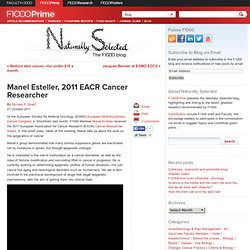
In this short video, taken at the meeting, Manel tells us about his work on the epigenetics of cancer. Manel’s group demonstrated that many tumour suppressor genes are inactivated not by mutations in genes, but through epigenetic changes. He is interested in the role of methylation as a cancer biomarker, as well as the roles of histone modification and non-coding RNA in cancer in prognosis. He is currently working on determining epigenetic profiles of human diseases—not just cancer but aging and neurological disorders such as Alzheimer’s. His lab is also involved in the preclinical development of drugs that target epigenetic mechanisms, with the aim of getting them into clinical trials.
Sometimes technology goes faster than knowledge.